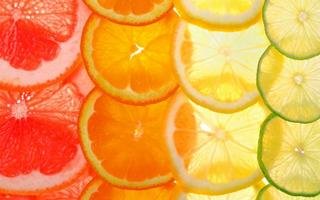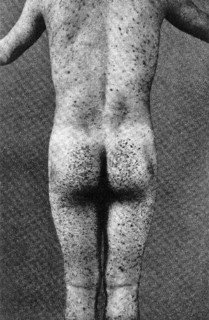VITAMIN C, SCURVY, AND A NOBEL PRIZE WINNER - by Jennifer Skyler - With Love From Portland
It's hard to believe, but over 100 years ago, no one had ever heard of a vitamin, let alone understood that vitamin deficiencies could lead to disease and death. Symptoms of lethargy, joint pain, vision problems, hair loss, sore gums, mental illness, and even death would occur and there was no understanding as to WHY. Take Vitamin C deficiency, for example, which causes the disease scurvy. While modern cases are rare, scurvy was once the reason for millions upon millions of human deaths.

Scurvy symptoms begin with appetite loss, diarrhea, rapid breathing, fever, irritability, tenderness and discomfort in legs, swelling over the long bones, bleeding (hemorrhaging), and feelings of paralysis. As the disease progresses, a scurvy victim may present bleeding of the gums, loosened teeth, petechial hemorrhage of the skin and mucous membranes (a tiny pinpoint red mark), bleeding in the eye, protruding eyeballs, constochondral beading (beading of the cartilage between joints), hyperkeratosis (a skin disorder), corkscrew hair, and sicca syndrome (an automimmune disease affecting connective tissue). Eventually, these symptoms resulted in death.

Humans at the greatest risk for the disease - besides those experiencing famine - were sailors. It has been estimated that between 1500 and 1850, scurvy was the cause for the death of as many as two million sailors. Typically, during that time period, half of all sailors on long voyages would succumb to scurvy and die. HALF. Eventually, it was noticed that the sailors seemed to recover when they would reach a port and receive fresh foods, but no one understood why. It wasn't for lack of trying. In the 1760's, William Stark, a Scottish physician attempted experiments on himself (foolishly), living on just bread and water to see what would happen. Unfortunately, he died six months into his experiment, from scurvy, before coming to any conclusions.
 Captain James Cook had an astonishing breakthrough in beating scurvy. Before his circumnavigation of the globe in 1768-71, he packed a range of foods to experiment with as scurvy preventatives, including 30 gallons of carrot marmalade and a hundred pounds of sauerkraut per crew member. No one died from scurvy on his voyage - which was a miracle at that time! Though praised by the The Royal Society, Captain James Cook's discovery was essentially ignored for the next one hundred years by the British Navy. In the 1850's, the British Navy finally began to ration lemon juice to its sailors, then eventually switched to limes (ever hear the term "limey"?). Unfortunately, limes are not as significant a source of Vitamin C as lemons, and so scurvy remained a threat to sailors during long voyages.
Captain James Cook had an astonishing breakthrough in beating scurvy. Before his circumnavigation of the globe in 1768-71, he packed a range of foods to experiment with as scurvy preventatives, including 30 gallons of carrot marmalade and a hundred pounds of sauerkraut per crew member. No one died from scurvy on his voyage - which was a miracle at that time! Though praised by the The Royal Society, Captain James Cook's discovery was essentially ignored for the next one hundred years by the British Navy. In the 1850's, the British Navy finally began to ration lemon juice to its sailors, then eventually switched to limes (ever hear the term "limey"?). Unfortunately, limes are not as significant a source of Vitamin C as lemons, and so scurvy remained a threat to sailors during long voyages.
 Discovered in the 1930's by the brilliant, Hungarian born, Albert Szent-Györgyi, Vitamin C is an essential nutrient that humans are incapable of synthesizing within our own bodies. It enables our bodies to efficiently use fats, carbohydrates, and proteins. As a free radical, Vitamin C neutralizes the damaging effects of free radicals. Vitamin C plays a key role in our bodies' production of collagen, which is the body's protein building block, playing a vital role in the health of every organ in the body. We must obtain Vitamin C through the foods we eat, or supplementation.
Discovered in the 1930's by the brilliant, Hungarian born, Albert Szent-Györgyi, Vitamin C is an essential nutrient that humans are incapable of synthesizing within our own bodies. It enables our bodies to efficiently use fats, carbohydrates, and proteins. As a free radical, Vitamin C neutralizes the damaging effects of free radicals. Vitamin C plays a key role in our bodies' production of collagen, which is the body's protein building block, playing a vital role in the health of every organ in the body. We must obtain Vitamin C through the foods we eat, or supplementation.
In 1933, using guinea pigs - as guinea pigs - Albert tested what happened when one test group of animals were given a diet of boiled foods devoid of vitamins (due to the boiling), and one group was given boiled food supplemented with a acid derivative Albert made from citrus. The guinea pigs who were not given the ascorbic acid developed scurvy-like symptoms and died. The guinea pigs given ascorbic acid flourished. Four years after Albert discovered ascorbic acid - or Vitamin C - he was awarded the Nobel Prize. In later research, Albert went on to discover the flavanoids in citrus fruit and postulated on their role in bolstering blood capillary blood vessels. Albert eventually went on to study the proteins needed for muscle contraction and the role of ATP. His brilliant work lay the foundation for Sir Hans Krebs, who discovered "the Krebs cycle".
As a holistic nutrition nerd, I have a deep, deep respect for the miraculous Vitamin C. Not only is it an essential nutrient, it can also be used in therapeutic doses to boost overall immunity and even fight cancer. Water soluble, Vitamin C leaves the body about four hours after it is consumed. Whatever your body doesn't use, will be excreted out through urine. If you "overdose" your body will let you know - you'll get tummy gurgles and diarrhea, but other than that, it can't harm you.
In fact, in order to saturate the body, pushing the intake up to "bowel tolerance" is often recommended by nutritionists and naturopaths. The body can handle high doses during times of high stress and illness. Want to break a fever? Try 8,000 milligrams. Want better skin tone and texture? Take Vitamin C! Fighting cancer? Consider getting Vitamin C IV treatments. IV treatments will not cause bowel symptoms, and the body can tolerate very high doses.
Personally, I use a buffered form of Vitamin C, called Ester-C. It has minerals added to diminish any acidic effect it might have on the digestive system. The Ester-C company has also come out with a formulation recently, which keeps the Vitamin circulating in the blood stream for up to 24 hours as opposed to the standard four.
Want to add more Vitamin C to your diet naturally? Consider adding these foods to your diet:
Strawberries, Citrus fruits, Papaya, Acerola cherry, Kiwis, Bell peppers, Guava, Brussel Sprouts, Watermelon, Leafy Greens (kale, mustard, chard, spinach), Amla fruit, Broccoli, Cauliflower, Tomatoes, Cilantro, Chives, Thyme, Basil, and Parsley.
Be Well, Steemers, and eat/take your Vitamin C!
With Love From Portland,
Jennifer Skyler

A really important aspect is the dosage - from 4-8 grams a day as a healthy maintenance dose, to around 10 -20 grams a day for a cold and 100 - 200 grams for diseases like cancer - big doses can turn things around fast. Liposomal works well up to about 20 grams but then it gets hard to fit more in at a max of 3 grams every 2 hours.
http://www.frot.co.nz/design/health/vitamin-c/
Nice post!
I also like liposomal C as it bypasses the stomach and gets absorbed in the small intestine. I'll look into the new Ester C you mentioned as well.